VITAL FUNCTIONS
In order to live, organisms use the function of nutrition to obtain the matter and energy they need.
They interact with their environment thanks to the function of interaction, and they continue to have descendants due to the function of reproduction.
NUTRITION
The purpose of nutrition is to renew and help preserve the organism’s structure as well as obtaining energy to perform the three vital functions.
Cellular metabolism is a combination of chemical reactions. This enables cells to obtain the necessary nutrients and energy to keep them alive.
In order to feed themselves, living things take substances from the environment which surrounds them, and cellular metabolism takes place in their cells.
Metabolism consists of two stages: anabolism and catabolism.
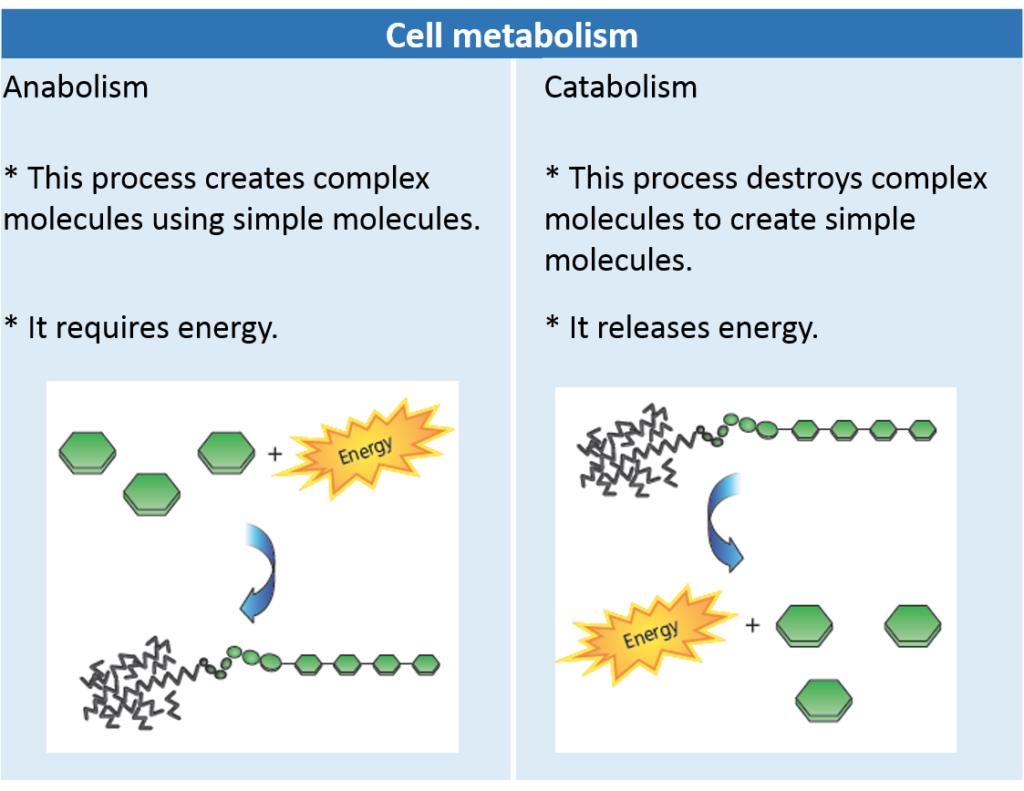
During cell metabolism, in addition to matter and energy, waste substances are released from the organism.
Nutrition types
There are two types of nutrition, depending on the type of matter obtained:
- Autotrophic nutrition: This type of nutrition is performed by organisms that obtain inorganic materials from the environment, which they transform into organic material. Plants, algae, and some bacteria perform autotrophic nutrition.
- Heterotrophic nutrition: This is performed by organisms that take organic matter from the environment. Examples of living things that use heterotrophic nutrition are: animals, fungi, protozoa and some bacteria.
INTERACTION
Interaction allows living things to interact with their environment, detect any changes in it and react to them.
Stimuli are the changes in the environment that may provoke a response in a living thing. They are perceived by the receptors, which are cells or structures specialised in perceiving stimuli.
Living things can respond to stimuli either with movements or by producing substances called hormones, which produce changes in how something functions or behaves.
REPRODUCTION
The purpose of reproduction is to create descendants and, in this way, continue the species.
There are two types of reproduction: asexual and sexual.
- Asexual reproduction: a single individual creates multiple descendants which are identical. It occurs in all unicellular organisms and in some multicellular ones. Unicellular living things only have one cell, so they can only reproduce by using the same cell.
There are three main types:
- • Bipartition: the cell divides into two cells of similar size.
- • Budding: the cell also divides into two cells, but this time they are very different in size.
- • Sporulation: one single individual divides its nucleus, creating many new individuals.
- • Sexual reproduction:it requires two individuals of opposite sex. The number of descendants is smaller than in asexual reproduction and the offspring are not identical. Multicellular organisms perform this type of reproduction.
Some species are capable of performing both types of reproduction.
ACTIVITIES
CELLS
Biomolecules group together to create cells: the smallest structures that can be considered living things.
Cells are the functional and structural units of all living things.
All living things, including human beings, are made of cells. This is why cells are structural units. At the same time, cells are the smallest structures capable of performing the three vital functions of nutrition, interaction and reproduction. This is why cells are also known as functional units.
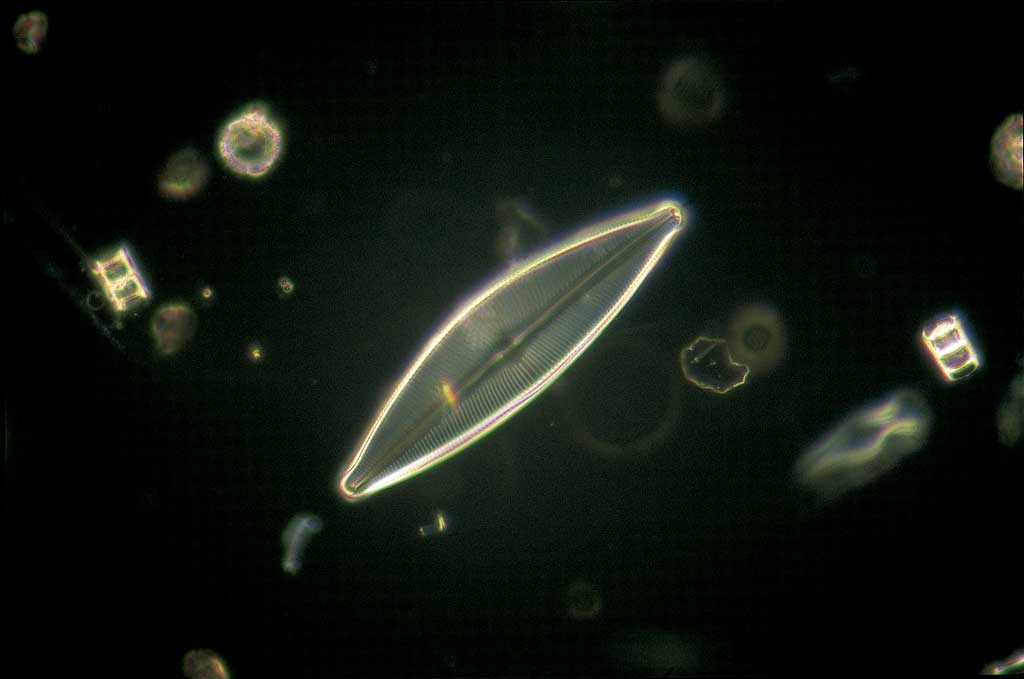
Diatom algae: an organism consisting of a single cell 
Elephant: a living thing made of many cells
As you can see, diatom algae and elephants are very different, so we divide living things into two categories:
- Unicellular: an organism consisting of a single cell, such as bacteria, fungi and algae.
- Multicellular: an organism consisting of more than one cell. All plants and animals are multicellular living things.
THE DISCOVERY OF CELLS: CELL THEORY
In 1665, the English scientist Robert Hooke first described a cell. He observed it using a rudimentary microscope which he had built himself. He observed a polygonal structure that was replicated multiple times inside thin sheets of cork. Hooke called this structure cella which means cell’ or gap’ in Latin.
In 1838, Matthias Schleiden and Theodor Schwann were the first scientists to formulate cell theory. This theory was later extended by other scientists, and nowadays it states that:
- All organisms are made of cells.
- Cells are the structural and functional units of living things.
- Every cell is the result of the division of a pre-existing cell.
- Cells are the simplest independent life units which we know of.
CELL STRUCTURE
Bacteria, skin cells and plant cells all have a basic structure, just like all cells found in nature. A cell consists of a plasma membrane, cytoplasm and at least one nucleic acid molecule.
- The plasma membrane is the envelope around the cell. It separates the inside of the cell from the exterior. It allows substances to enter and exit the cell. In addition to this membrane, some cells have another rigid outer casing which is called the cell wall.
- Cytoplasm is a watery substance found in the interiors of cells. In some cells, we can find organelles, which are specialised structures that perform specific functions. For example, a mitochondrion performs cellular respiration.
- The nucleic acid contains genetic information which is essential for the functioning of the cell. It can be dispersed within the cytoplasm, or surrounded by a membrane, which is called the nuclear membrane.
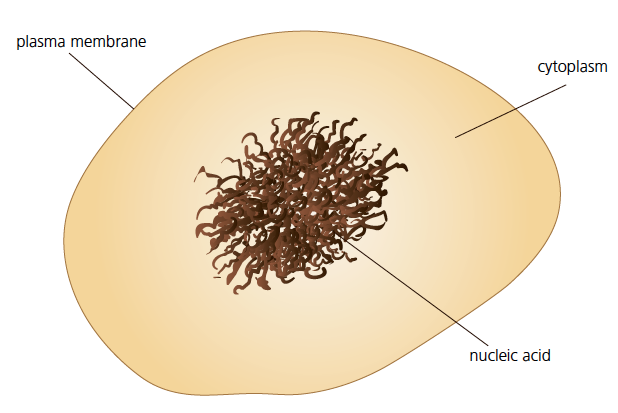
Cell size
Cells exist in different sizes, although generally they are microscopic. To measure cells we use micrometres (µm):
1 µm = 0.001 mm = 0.000001 m
1m = 1000 mm = 1000000 µm
CELL TYPES
Different species of living things have different amounts of cells as well as different cell structures. We can classify cells into two types according to their structures: prokaryotes and eukaryotes. Eukaryote cells differ according to whether they are found in animals or plants.
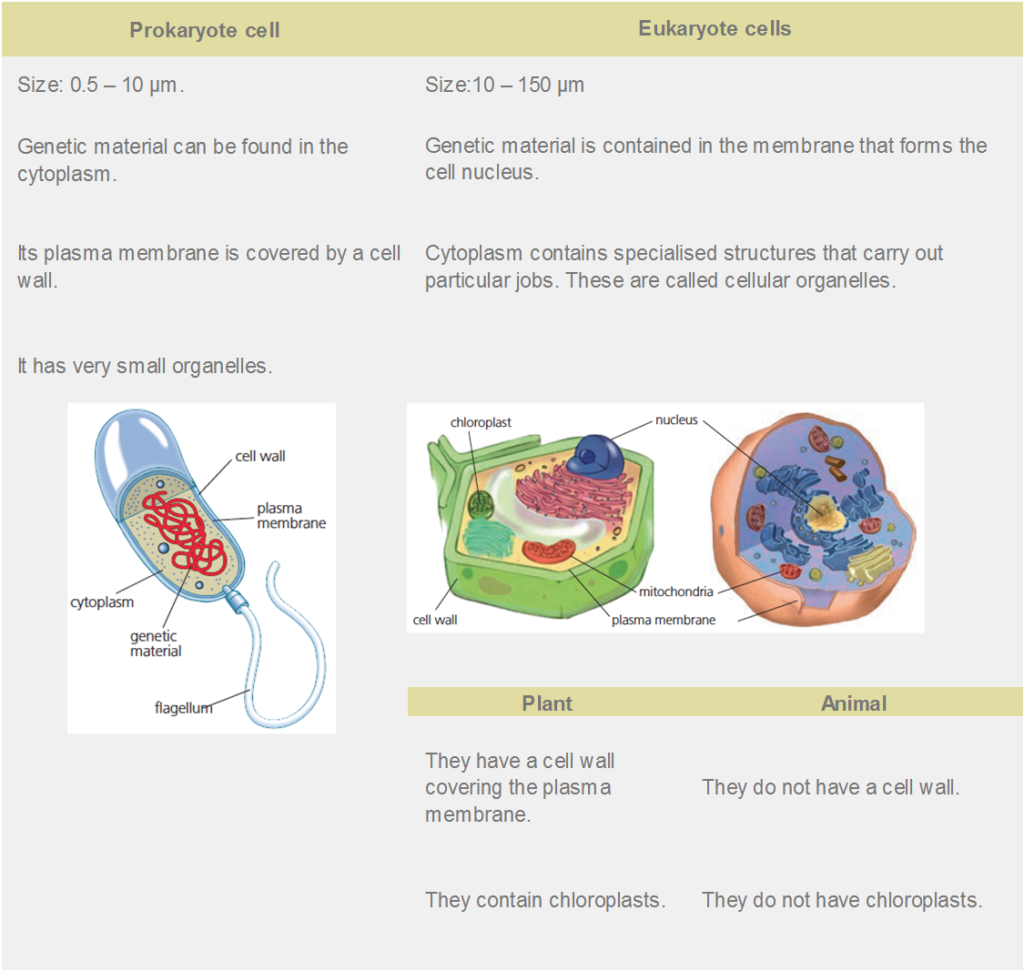
THE ENDOSYMBIOTIC THEORY
This theory was formulated by Lynn Margulis in 1967. It states that eukaryote cells originated from the interaction of several primitive prokaryote cells 500 million years ago.
Margulis proved that mitochondria and chloroplasts originated from primitive bacteria. Her theory is widely accepted by the scientific community.
CELL SPECIALISATION
Multicellular living things are made up of many cells. All cells in living things have a common characteristic: they have the same genetic material (DNA).
However, within the same organism, we can find many different types of cell. Each of them is specialised to perform a particular job.
Every type of cell uses one part of the information found in the DNA, as if the cell was reading a chapter of an instruction manual. This is known as cell specialisation.
Cell specialisation gives multicellular living things many advantages:
- Division of labour: Each type of cell performs a different job so living things can multitask.
- Greater efficiency: Because they do specific jobs, they do them very efficiently.
- Longevity: Damaged cells can be replaced by other cells. This means that multicellular organisms are more likely to survive.
However, multicellular living things need more energy to allow the different structures and functions to work at the same time.
Actividades
2. BIOELEMENTS AND BIOMOLECULES
Living things, like all matter in the universe, are made up of very small particles called atoms. These particles are so small you would not be able to see them, even if you used a microscope.
Atoms are the first structural level of matter and they organise themselves into molecules.
We know 117 different types of atom. Each of them constitutes a chemical element. A chemical element is a form of matter composed of atoms of the same type.
BIOELEMENTS
Bioelements are the units which living things are composed of.
The atoms that make up all living things mostly consist of six different chemical elements: carbon (C), oxygen (O) hydrogen (H), nitrogen (N), phosphorus (P) and sulphur (S). These elements constitute more than 99% of the matter found in living things. They are called primary bioelements.
Carbon atoms have the ability to link to other atoms. This allows life to take place and is why carbon is the most important bioelement.
Other chemical elements are found in living things; however, they appear in smaller quantities. We refer to them as secondary bioelements. They are: calcium (Ca), sodium (Na), magnesium (Mg) and potassium (K).
Lastly, trace elements are elements which are found in living things, but only in small amounts (0.1%). Although trace elements are not common, they are also important for certain functions. Examples of these are: iron (Fe) and iodine (I).
BIOMOLECULES
Bioelements join together to form different biomolecules. Biomolecules are what living things are made of.
Some biomolecules are exclusive to living things. They are known as organic biomolecules. These are: carbohydrates, lipids, proteins and nucleic acids.
Inorganic biomolecules (water or mineral salts) are also found in both living things and non-living things.
Water is essential for the existence of life and is the most common biomolecule. Between 50% and 95% of the weight of any living thing is water.
Percentage of water content of some living things
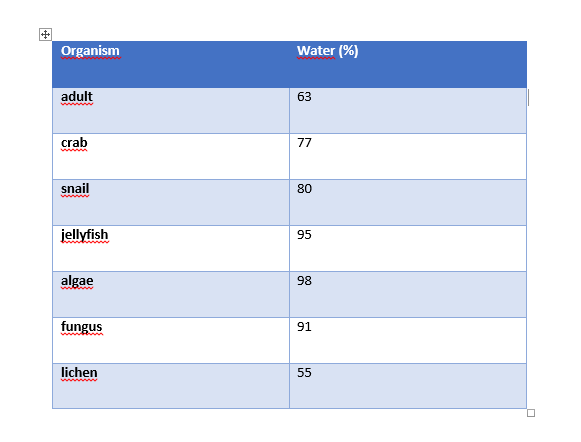
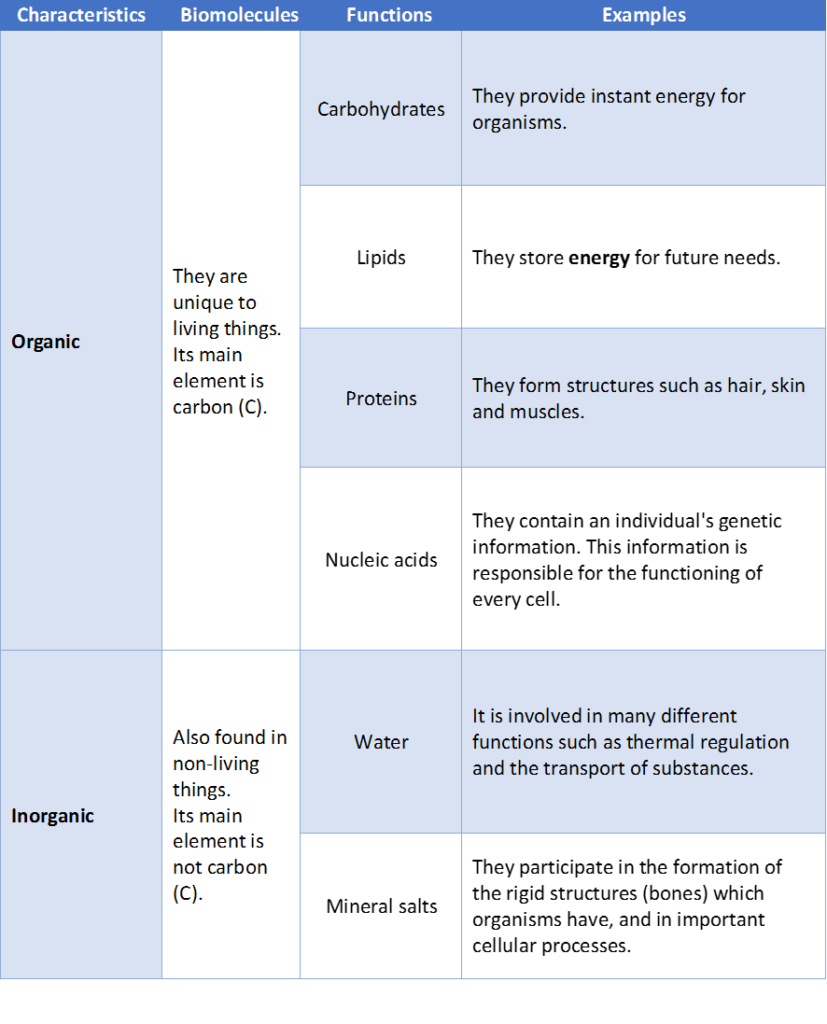
Actividades
Toefl first test
Vocabulary

Listen task 1
Listen task 2
Listen task 3
Listen task 4
Listen task 5
Listen task 6
Listen task 7
Listen task 8
Listen task 9
Listen task 10
Listen task 11
Catching up after a trip

Listen to two friends talking about a recent trip abroad to practise and improve your listening skills.
Do the preparation task first. Then listen to the audio and do the exercises.
Preparation
See moreListening C1: Catching up after a trip – preparation
Transcript
See moreDave: Jean, hi!
Jean: Hi, Dave. How are you?
Dave: Good, good.
Jean: Wait a second, I’m not calling you in Canada, right? You’re back now, aren’t you?
Dave: Yeah, I got back two days ago.
Jean: Oh good, phew. Because I wouldn’t want to be calling you long distance without realising it and suddenly …
Dave: You’ve spent a fortune on a long-distance call. No, I know, it’s OK. I actually wouldn’t answer the phone while I was over there if I saw the call was coming from England. But no worries, we’re in the same country now.
Jean: Yeah. So, how was the trip? Did you meet your long-lost uncle?
Dave: I did, actually. It was very good. I flew to Toronto and stayed there for a few days. At first I was really worried about my accommodation because I kept reading these appalling stories about rental flats going all wrong.
Jean: Oh, was it one of those?
Dave: Yeah.
Jean: My friend had a disastrous experience in Barcelona with one of them. The place didn’t look anything like the photos, and all the neighbours hated that there was a holiday flat in their building. Awkward situation. Urgh.
Dave: Right. So, as I was saying, I was really worried because I heard these stories. And at first I couldn’t find the place. Turns out I was in the wrong building. It was next door, and on the top floor, and … wow. Jean, this place was fabulous! Really spacious, with these floor-to-ceiling windows and the most scenic views of the city. I could see the lake and the whole city skyline and skyscrapers from my bedroom. I had to pinch myself to prove I wasn’t dreaming.
Jean: Sounds pretty cool. So, what’s it like? The city, I mean. I’ve always wanted to go to Canada.
Dave: It’s nice. I mean, it’s another big, vibrant, modern city. But it’s really clean, and there’s lots of parks. One of the things I liked was the multiculturalism. We visited Chinatown, Little Italy, Greektown, Little India … umm, I can’t remember the others but it was sort of a new area every three or four blocks, you know?
Jean: Hey, is it true that there’s a whole part of the city that’s underground? I read that somewhere about Toronto, or saw it on some TV show.
Dave: It’s true! I asked about that. They call it the PATH. There’s, like, almost 30 kilometres of restaurants, shops, cinemas and stuff all underground. In the middle of the downtown area.
Jean: Amazing!
Dave: Yeah, but actually once you’re down there it’s not that noticeable. There’s actually a lot of natural light. I forgot we were underground. It’s mostly useful to get out of the cold weather.
Jean: What temperature was it while you were there?
Dave: It was still only November, but it was getting cold. We had at least a day where it was less than zero. My uncle told me that in January and February it can go down to 20 below zero.
Jean: Oh, wow. I think I’d die!
Dave: Yeah, and the worst thing was what they call the ‘wind-chill’ factor. So they say the temperature is zero degrees, but minus eight with the wind chill. So it feels like minus eight. And my uncle said the wind-chill factor can go down to minus 40.
Jean: Stop it! You’re making me feel cold just thinking about it. So, how was meeting your uncle? The famous Uncle George.
Dave: That was great too. He lives outside of Toronto, in a cottage by a lake. Really tranquil and unspoiled nature.
Jean: I’m dying to see photos. You want to meet up soon? Or are you too jet lagged still?
Dave: Yeah, I’m actually free tomorrow if you like.
Task 1
See moreListening C1: Catching up after a trip – 1
Task 2
See moreListening C1: Catching up after a trip – 2
Choose the correct option to complete the sentence.
Birthday parties

Listen to a conversation about birthday parties between three friends to practise and improve your listening skills.
Do the preparation task first. Then listen to the audio and do the exercises.
Preparation
See moreListening C1: Birthday parties – preparation
Transcript
See moreMarco: The big four-oh, Charles!
Dora: Oh!! It’s your 40th!
Marco: Are you planning a party?
Charles: Nah, I never celebrate birthdays. I don’t see why this one should be any different.
Dora: Why not?
Charles: First, you know me, I can’t be bothered with the hassle. It’s my birthday but I’m supposed to do all the hard work – contacting people, finding a venue, organising food, worrying who will show up. No, thanks.
Marco: Ah, someone’s angling for a surprise party, eh, Dora?
Charles: Marco, stop! Even worse. Having to pretend to be delighted 50 people just sprang up in your living room when you thought you were coming home to put your feet up. Probably having a heart attack at the shock.
Dora: Note to self: never to organise you a surprise party. OK then!
Marco: You’ve got to do something, though, Charles. It’s your 40th.
Charles: Why? What’s so great about getting old?
Dora: Er … still being here to have your birthday?
Marco: Yeah, ‘Ageing is better than the alternative’, as they say.
Dora: Yeah, and it’s true – so why not celebrate?
Charles: You guys can have parties for your 40ths if you like. I just don’t go in for that kind of self-indulgent attention-seeking.
Dora: Wow, that’s a bit harsh! I had a huge bash for my 30th. And you came. And enjoyed yourself if I recall. Are you trying to say I was just doing it for attention?
Charles: Not exactly … but … well … at least a small part of you must have been.
Dora: Remind me not to invite you to my 40th then, so you won’t have to put up with my huge ego while I feed you and provide free drinks all night because I thought we were friends.
Charles: I meant, er, I mean, not all attention-seeking is bad. It’s just not my style is all.
Dora: Whereas it is mine?
Marco: Anyway …
Charles: I didn’t say that!
Dora: Er, yes, yes, you did. You said celebrating birthdays is self-indulgent and …
Marco: Guys, guys! Who knew birthdays was such a touchy subject? Speaking of which, I have to sort out my nine-year-old’s party the weekend after next.
Charles: Now, that’s a party I’d love to organise.
Marco: Really? It’s a nightmare. It’s not like when we were kids. Now you have to take them all rock-climbing or hire a make-up artist to come and teach them how to look like a zombie or a film star. And there’d be trouble if someone else in school had the same kind of party and your kid gets accused of copying. That fear you said about no one turning up? It’s a million times worse when you’re scared your kid is going to have no one turn up.
Charles: Is there that much pressure?
Marco: Yeah, it’s crazy. Last year, I got it right with a cinema trip. Simple, but always a winner. But we can’t do the same thing again apparently. It says it in my ‘Official Laws for 9-Year-Olds’ book.
Charles: That’s a pity. I’ve got so many fond memories of birthday parties as a kid. Party food and games and watching cartoons until your parents arrived.
Marco: Trust me, your parents were stressing out!
Dora: At the risk of restarting the argument, when do you think you stopped enjoying birthdays then?
Charles: I dunno really … somewhere around moving away from home and getting a job and being a grown-up. I don’t mean birthdays are immature. I mean, it takes a while to make new friends and so birthdays just become more low-key and it’s drinks with a couple of friends or dinner or something. And I just got out of the habit, I guess. Maybe I just need to have a kids-style party like we used to have! Play musical chairs and eat pineapple and cheese on sticks and all that.
Dora: Very retro. I bet people would love that.
Marco: Yeah, they would. Well, I would anyway. And maybe it’ll catch on with my kids and it’ll start a new party trend.
Charles: You’ve got me thinking … it’s not a terrible idea. Maybe I will have a party this year!
Task 1
See moreTask 2
See moreListening C1: Birthday parties – 2
Instructions for an assignment

Listen to a university teacher giving instructions for an assignment to practise and improve your listening skills.
Do the preparation task first. Then listen to the audio and do the exercises.
Preparation
See MoreTranscript
See MoreI want to explain a few things about your essay.
First of all, the deadline. The deadline for this essay is October the 18th. Not the 19th, not the 28th, not two days later because your dog was ill or your computer broke – the 18th. If it’s late, I won’t mark it. I won’t even read it – you’ll fail the assignment! So, please hand it in on time. You can even hand it in early, if you like!
You can email me the essays at j.hartshorn@lmu.ac.uk. That’s H-A-R-T-S-H-O-R-N. I’ll reply to say I’ve got it. If I don’t reply within a day, it might mean I didn’t get it, so please email me again to make sure. You can also bring a paper copy of the essay to my office, but let’s be kind to the trees, OK? Email is better for the trees and for me.
Don’t forget that you must reference every idea or quote you use that isn’t your own idea. And the last page of your essay should be a list of all the books you used, in alphabetical order, not in the order you used them!
And lastly, make it easy for me to read! That means use a clear font. Arial is best, but Times New Roman is fine too. Not Comic Sans please! Size 12 font for the essay, and size 14 for the titles and subheadings. And use page numbers. Any questions?
Task 1
See MoreTask 2
See MoreGetting advice

Listen to someone getting advice from a friend to practise and improve your listening skills.
Do the preparation task first. Then listen to the audio and do the exercises.
Preparation
See MoreListening B2: Getting advice – preparation
Match the words with the definitions.
Transcript
See MoreClara: Hi, how are you? I haven’t seen you in class for a while.
Ben: Good, thanks. You?
Clara: Great, as long as I don’t think too hard about all the essays I have to write this term!
Ben: Yeah …
Clara: Hey, are you OK?
Ben: I have to admit, I’m struggling a bit. Maybe even a lot. I’ve not been sleeping well at all and then I can’t concentrate. And all these things are just going around and around in my head.
Clara: Mmm … that doesn’t sound good. So, you’re sleeping badly and you can’t concentrate. Is that all it is, do you think?
Ben: Well, if I’m honest, it’s more than that. I’m starting to dread going outside. I find myself worrying about stupid things like what if I forget the way home. Or, what if I go to class thinking it’s Monday but actually it’s Friday and I’m in the wrong place at the wrong time. It sounds even more stupid when I say it out loud. It took me two hours to leave the house today.
Clara: It doesn’t sound stupid at all. It actually sounds a lot like me last year.
Ben: Really? But you’re so together!
Clara: I’ve learned to be, but even I still have bad days. I used to have panic attacks and everything. When you were trying to leave the house today, how did you feel?
Ben: Like I couldn’t breathe. And my heart was going way too fast.
Clara: Hmm … that sounds like a panic attack to me.
Ben: I thought I was going to die.
Clara: You’d be surprised how common they are. Loads of people have them, they just don’t talk about it.
Ben: How did you get over them?
Clara: I actually talked to a doctor about it, and you should too. But I learned some practical things as well. Though they’re easier said than done, and they’re going to sound weird, so hear me out, OK?
Ben: OK …
Clara: So, one thing I did was to try to reduce the power of the anxiety and the panic attacks when they came. So – and this may sound strange – at a time when you’re feeling safe and OK, you literally do things that make your heart start racing faster and your breathing speed up. Like spinning around on a chair until you’re dizzy or hyperventilating so you’re short of breath.
Ben: That sounds awful!
Clara: It is, but it means you get used to the symptoms, so they feel less scary.
Ben: Right.
Clara: Then you have to deliberately do the things that usually make you feel panic. So, if it’s going to class on Monday and being scared you’ve got the wrong day, on Monday you go to class. If you let the anxiety control you by making you stay at home, it just makes it worse the next time you really do have to go out.
Ben: And what did you do if a panic attack came anyway?
Clara: I had a distraction plan. So, I walked everywhere instead of taking the bus because the exercise helped, but also I did things like count trees or red cars or something. Whatever it was didn’t matter, as long as I had something else to focus on.
Ben: I can’t tell you how much I appreciate this. I thought …
Task 1
See MoreTask 2
See MoreListening B2: Getting advice – 2
Put the pieces of advice in the order you hear them.
At the chemist
Listen to a conversation at a chemist’s to practise and improve your listening skills.
Do the preparation task first. Then listen to the audio and do the exercises.
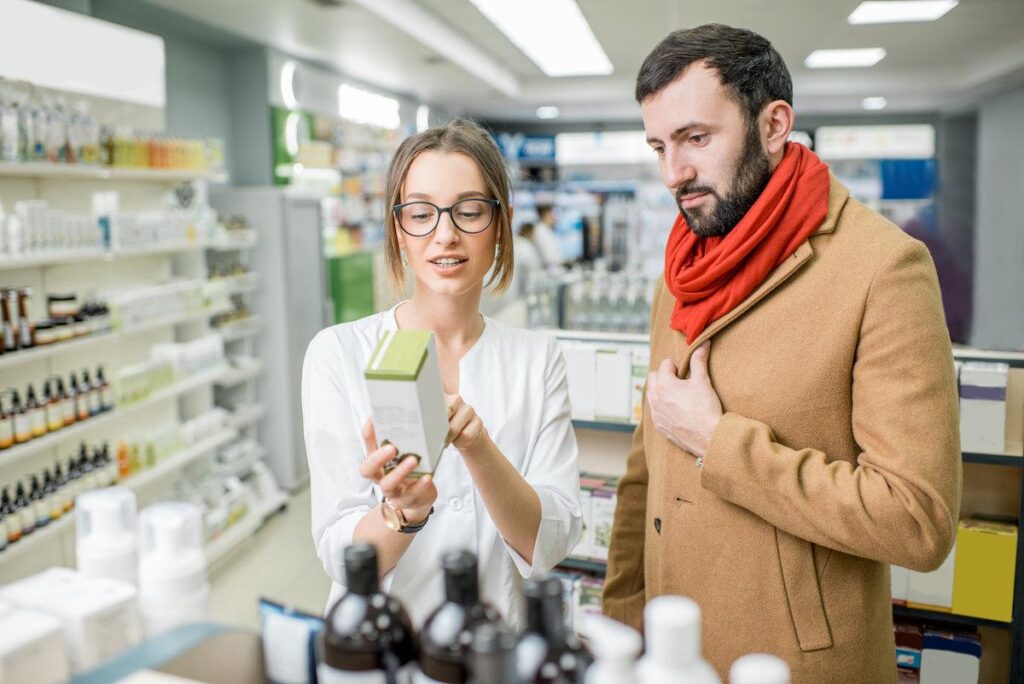
Preparation
See moreListening B1: At the chemist – preparation
Put the words in the correct group.
Transcript
See moreChemist: Hello, can I help?
Customer: Yes, my wife sent me here. I, erm, need something for a sore throat … and I can’t stop coughing. It really hurts.
Chemist: Do you have a headache too?
Customer: Not really, no.
Chemist: Well, we have this syrup. And these lozenges.
Customer: Which is better?
Chemist: They’re both good. The syrup is more expensive.
Customer: Oh, well … I’ll take the lozenges, then. How many do I take?
Chemist: Just one.
Customer: Sorry, I’m sorry. Er, how often should I take it?
Chemist: Just one every four to six hours. Take it before mealtimes. Are you allergic to any medicine?
Customer: No.
Chemist: Then you’ll be fine with this.
Customer: Can I get some antibiotics too?
Chemist: I’m afraid you need a prescription for that.
Customer: Ah.
Chemist: You know, you should really see a doctor if that cough continues.
Customer: Thanks. I know.
Chemist: Anything else?
Customer: No, thanks.
Chemist: That’ll be £7.49 then, please.
Comentarios recientes